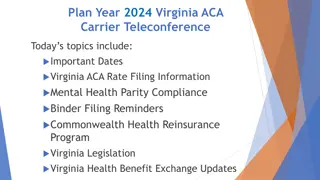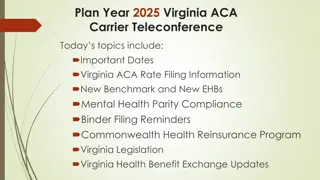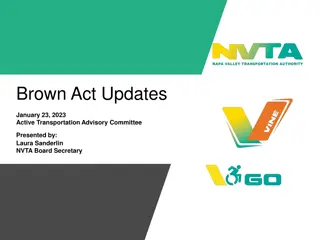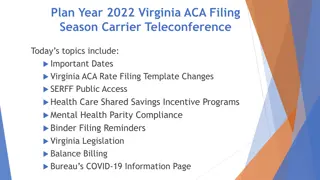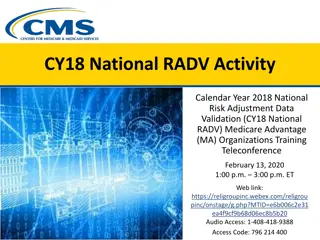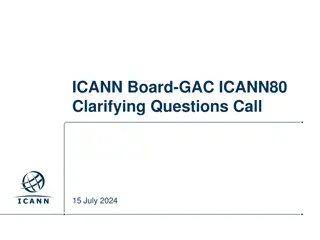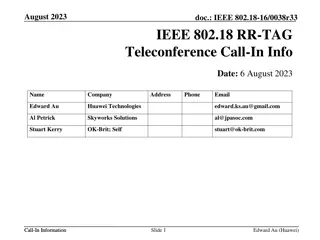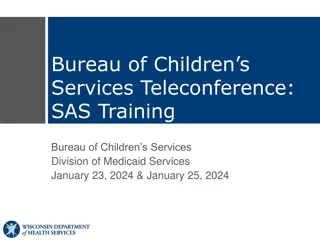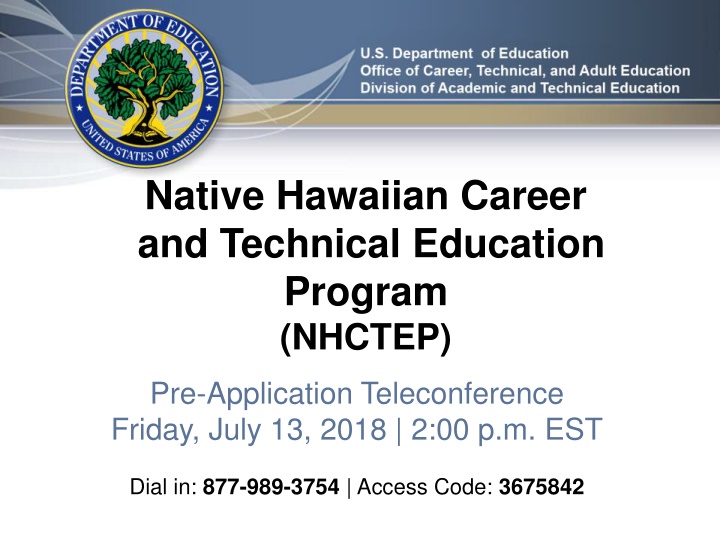
Native Hawaiian Career Education Program Pre-Application Teleconference Details
Learn about the Native Hawaiian Career and Technical Education Program (NHCTEP) through a pre-application teleconference on July 13, 2018, covering program purpose, award information, eligibility, application instructions, and key deadlines. Dial in to participate and get insights into improving career and technical education for Native Hawaiian students.
Download Presentation

Please find below an Image/Link to download the presentation.
The content on the website is provided AS IS for your information and personal use only. It may not be sold, licensed, or shared on other websites without obtaining consent from the author. If you encounter any issues during the download, it is possible that the publisher has removed the file from their server.
You are allowed to download the files provided on this website for personal or commercial use, subject to the condition that they are used lawfully. All files are the property of their respective owners.
The content on the website is provided AS IS for your information and personal use only. It may not be sold, licensed, or shared on other websites without obtaining consent from the author.
E N D
Presentation Transcript
Native Hawaiian Career and Technical Education Program (NHCTEP) Pre-Application Teleconference Friday, July 13, 2018 | 2:00 p.m. EST Dial in: 877-989-3754 | Access Code: 3675842
Pre-Application Teleconference Access/Logistics Teleconference Access Information: Dial-in Number: 877-989-3754 Participant Access Code: 3675842 Logistics: The entire presentation will be in listening mode. After roll call is taken, please Mute your telephones. Do not place this call on hold. We recommend that you take notes during the presentation. After the conclusion of the presentation, you may email your questions to NHCTEPgrant@ed.gov. 2
Grants.gov Native Hawaiian Career and Technical Education Program (NHCTEP) Federal Register Notice Inviting Applications and Application Package (CFDA 84.259A) http://www.grants.gov 3
Topics to be Covered Federal Register Notice 1. Program Purpose 2. Award Information 3. Eligibility 4. Invitational Priority 5. Program Requirements 6. Selection Criteria 7. Performance Measures 8. Budget Information 9. Review & Selection Process 10. Risk Assessment & Special Conditions 11. Open Licensing Requirement Application/Instructions 12. The Application 13. Contact Information 4
1. Purpose of the NHCTEP to improve career and technical education (CTE) programs that are consistent with the purposes of the Carl D. Perkins Career and Technical Education Act of 2006 (the Act) and that benefit Native Hawaiian students. 5
2. Award Information Type of Award: Discretionary Grants Estimated Number of Awards: 10 Estimated Range of Awards: $250,000 to $500,000 Average Award Size: $276,000 Project Period: Up to 36 months The U.S. Department of Education (ED) is not bound by any of these estimates. 6
2. Award Information Key Deadlines Notice of Intent to Apply deadline: Monday, July 9, 2018 We will be able to develop a more efficient process for reviewing grant applications if we have a better understanding of the number of applications that we will receive. The notice of intent to apply is optional. Send an e-mail to NHCTEPgrant@ed.gov with Intent to Apply in the e-mail subject line. Application submission deadline: Friday, July 27, 2018 7
3. Eligible Applicants The following entities are eligible to apply under this competition: Community-based organizations primarily serving and representing Native Hawaiians. For purposes of the NHCTEP, a community-based organization means a public or private organization that provides career and technical education, or related services, to individuals in the Native Hawaiian community. Any community-based organization may apply individually or as part of a consortium with one or more eligible community-based organizations. (Eligible applicants seeking to apply for funds as a consortium must meet the requirements in 34 CFR 75.127- 75.129.) 8
4. Invitational Priority The Secretary is particularly interested in receiving applications that propose creating or expanding opportunities for individuals to obtain recognized postsecondary credentials in science, technology, engineering, mathematics, or computer science. *Responding to the invitational priority is optional and does not result in earning bonus points. 9
5. Program Requirement #1 Authorized Programs Under the Native Hawaiian program, projects must-- Develop new programs, services, or activities or improve or expand existing programs, services, or activities that are consistent with the purposes of the Act. In other words, the Department will support expansions or improvements that include, but are not necessarily limited to, the expansion of effective programs or practices; upgrading of activities, equipment, or materials; increasing staff capacity; adoption of new technology; modification of curriculum; or implementation of new policies to improve program effectiveness and outcomes; and Fund a CTE program, service, or activity that-- Is a new program, service, or activity that was not provided by the applicant during the instructional term (a defined period, such as a semester, trimester, or quarter, within the academic year) that preceded the request for funding under NHCTEP; Will improve or expand an existing CTE program; or 10
5. Program Requirement #1 Authorized Programs (continued) Inherently improves CTE. A program, service, or activity inherently improves CTE if it Develops new CTE programs of study for approval by the appropriate accreditation agency; Strengthens the rigor of the academic and career and technical components of funded programs; Uses curriculum that is aligned with industry-recognized standards and will result in students attaining industry-recognized credentials, certificates, or degrees; Integrates academics (other than remedial courses) with CTE programs through a coherent sequence of courses to help ensure learning in the core academic and career and technical subjects; Links CTE at the secondary level with CTE at the postsecondary level and facilitates students' pursuit of a baccalaureate degree; Expands the scope, depth, and relevance of curriculum, especially content that provides students with a comprehensive understanding of all aspects of an industry and a variety of hands-on, job-specific experiences; or 11
5. Program Requirement #1 Authorized Programs (continued) Offers Work-related experience, internships, cooperative education, school-based enterprises, studies in entrepreneurship, community service learning, and job shadowing that are related to CTE programs; Coaching/mentoring, support services, and extra help for students after school, on the weekends, or during the summer, so they can meet higher standards; Career guidance and academic counseling for students participating in CTE programs under NHCTEP; Placement services for students who have successfully completed CTE programs and attained a technical skill proficiency that is aligned with industry- recognized standards; Professional development programs for teachers, counselors, and administrators; 12
5. Program Requirement #1 Authorized Programs Offers (continued) Strong partnerships among grantees and local educational agencies, postsecondary institutions, community leaders, adult education providers, and, as appropriate, other entities, such as employers, labor organizations, parents, and local partnerships, to enable students to achieve State academic standards and attain career and technical skills; The use of student assessment and evaluation data to improve continually instruction and staff development; or Research, development, demonstration, dissemination, evaluation and assessment, capacity-building, and technical assistance, related to CTE programs. 13
5. Program Requirement #2 Evaluation Each grantee must budget for and conduct an ongoing evaluation of the effectiveness of its NHCTEP project. An independent evaluator must conduct the evaluation. The evaluation must be appropriate for the project and be both formative and summative in nature. 14
5. Program Requirement #3 Student Stipends A portion of an award may be used to provide stipends to students to help meet the students costs of participation in a NHCTEP project. To be eligible for a stipend, a student must be enrolled in a CTE project funded under this program; be in regular attendance in a NHCTEP project and meet the training institution's attendance requirement; and maintain satisfactory progress. Students must have an acute economic need that prevents participation in a project funded under this program without a stipend; and cannot be met through a work-study program. Grantees must maintain records that fully support their decisions to award stipends to students An eligible student may receive a stipend when taking a course for the first time. However, a stipend may not be provided to a student who has already taken, completed, and had the opportunity to benefit from a course and is merely repeating the course. An applicant must include in its application, the procedure it intends to use to determine student eligibility for stipends and stipend amounts, and its oversight procedures for the awarding and payment of stipends. 15
5. Program Requirement #4 Direct Assistance to Students A grantee may provide direct assistance to an individual who is a member of a special population and who is participating in the grantee s NHCTEP project. The direct assistance must be needed to address barriers to the individual's successful participation in that project. The direct assistance is part of a broader, more generally focused program or activity to address the needs of an individual who is a member of a special population. The grant funds used for direct assistance must be expended to supplement, and not supplant, assistance that is otherwise available from non-Federal sources. 16
5. Program Requirement #5 CTE Agreement Any applicant that is not proposing to provide CTE directly to Native Hawaiian students and proposes instead to pay one or more qualified educational entities to provide such CTE to Native Hawaiian students must include with its application a written CTE agreement between the applicant and the educational entity. The written agreement must describe the commitment between the applicant and the educational entity and must include, at a minimum, a statement of the responsibilities of the applicant and the entity. The agreement must be signed by the appropriate individuals on behalf of each party, such as the authorizing official or administrative head of the applicant Native Hawaiian community-based organization. 17
5. Program Requirement #6 Supplement-not-Supplant Grantees may not use funds under NHCTEP to replace otherwise available non-Federal funding for direct assistance to students (as defined elsewhere in this notice under the heading Definitions) and family assistance programs. For example, NHCTEP funds must not be used to supplant non- Federal funds to pay the costs of students' tuition, dependent care, transportation, books, supplies, and other costs associated with participation in a CTE program. Further, funds under NHCTEP may not be used to replace Federal student financial aid. The Act does not authorize the Secretary to fund projects that serve primarily as entities through which students may apply for and receive tuition and other financial assistance. 18
5. Program Requirement #7 Statutory Requirement Limiting Services Section 315 of the Act prohibits the use of funds received under the Act to provide vocational and technical education programs to students prior to the seventh grade, except that equipment and facilities purchased with funds under the Act may be used by such students. (20 U.S.C. 2395). 19
6. Selection Criteria The selection criteria for this program are as follows: (a) Quality of the Project Design (up to 35 pts.) (b) Quality of the Management Plan (up to 15 pts.) (c) Quality of Project Personnel (up to 25 pts.) (d) Adequacy of Resources (up to 20 pts.) (e) Quality of the Project Evaluation (up to 25 pts.) 20
6. Selection Criteria- Quality of the Project Design (a) Quality of the Project Design. (35 points) In determining the quality of the design of the proposed project, we consider the following factors: (1) The extent to which the design of the proposed project is appropriate to and will successfully address the needs of the target population or other identified needs (as evidenced by such data as local labor market demand, occupational trends, and surveys). (Up to 5 points) (2) The extent to which goals, objectives, and outcomes are clearly specified and measurable. (For example, we look for clear descriptions of proposed student career and technical education activities; recruitment and retention strategies; expected student enrollments, completions, and placements in jobs, military specialties, and continuing education/training opportunities; the number of teachers, counselors, and administrators to be trained; and identification of requirements for each program of study to be provided under the project, including related training areas and a description of performance outcomes.) (Up to 10 points) (3) The extent to which the proposed project will establish linkages with other appropriate agencies (e.g., community, State, and other Federal resources) and organizations providing services to the target population in order to improve services to students and strengthen outcomes for the proposed project. (Up to 5 points) 21
6. Selection Criteria Quality of the Project Design (continued) (4) The extent to which the services to be provided by the proposed project will create and offer activities that focus on enabling participants to obtain the skills necessary to gain employment in high-skill, high-wage, and high-demand occupations in emerging fields or in a specific career field. (Up to 5 points) (5) The extent to which the services to be provided by the proposed project will create opportunities for students to acquire skills identified by the State at the secondary level or by industry-recognized career and technical education programs for licensure, degree, certification, or as required by a career or profession. (Up to 5 points) (6) The extent to which the proposed project will provide opportunities for high- quality training or professional development services that (i) Are of sufficient quality, intensity, and duration to lead to improvements in practice among instructional personnel; 22
6. Selection Criteria- Quality of the Project Design (ii) Will improve and increase instructional personnel's knowledge and skills to help students meet challenging and rigorous academic and career and technical skill proficiencies; (iii) Will advance instructional personnel's understanding of effective instructional strategies that are supported by scientifically based research; and (iv) Include professional development plans that clearly address ways in which learning gaps will be addressed and how continuous review of performance will be conducted to identify training needs. (Up to 5 points) 23
6. Selection Criteria Quality of the Management Plan (b) Quality of the Management Plan (15 points). In determining the quality of the management plan for the proposed project, we consider the following factors: (1) The adequacy of the management plan to achieve the objectives of the proposed project on time and within budget, including clearly defined responsibilities, timelines, and the milestones and performance standards for accomplishing project tasks. (Up to 5 points) (2) The extent to which the time commitments of the project director and other key project personnel, including instructors, are appropriate and adequate to meet the objectives of the proposed project. (Up to 5 points) (3) The adequacy of procedures for ensuring feedback and continuous improvement in the operation of the proposed project. (Up to 5 points) 24
6. Selection Criteria Quality of Project Personnel (c) Quality of Project Personnel (25 points). In determining the quality of project personnel, we consider the following factors: (1) The extent to which the applicant encourages applications for employment from persons who are members of groups that have traditionally been underrepresented based on race, color, national origin, gender, age, or disability. (Up to 5 points) (2) The qualifications, including relevant training, expertise, and experience, of the project director. (Up to 10 points) (3) The qualifications, including relevant training, expertise, and experience, of key project personnel, especially the extent to which the project will use instructors who are certified to teach in the field in which they will provide instruction. (Up to 5 points) (4) The qualifications, including training, expertise, and experience, of project consultants. (Up to 5 points) 25
6. Selection Criteria Adequacy of Resources (d) Adequacy of Resources (20 points). In determining the adequacy of resources for the proposed project, we consider the following factors: (1) The adequacy of support, including facilities, equipment, supplies, and other resources, from the applicant organization(s) and the entities to be served, including the evidence and relevance of commitments (e.g., articulation agreements, memoranda of understanding, letters of support, or commitments to employ project participants) of the applicant, local employers, or entities to be served by the project. (Up to 10 points) (2) The extent to which the budget is adequate and costs are reasonable in relation to the objectives and design of the proposed project. (Up to 5 points) (3) The potential for continued support of the project after Federal funding ends. (Up to 5 points) 26
6. Selection Criteria Quality of the Project Evaluation (e) Quality of the Project Evaluation (25 points). In determining the quality of the evaluation, we consider the following factors: (1) The extent to which the methods of evaluation proposed by the grantee are thorough, feasible, and appropriate to the goals, objectives, and outcomes of the proposed project1. (Up to 10 points) (2) The extent to which the methods of evaluation include the use of objective performance measures that are clearly related to the intended outcomes of the project and the performance measures discussed elsewhere in this notice and will produce quantitative and qualitative data, to the extent possible. (Up to 5 points) (3) The extent to which the methods of evaluation will provide performance feedback and continuous improvement toward achieving intended outcomes. (Up to 5 points) (4) The quality of the proposed evaluation to be conducted by an external evaluator with the necessary background and technical expertise to carry out the evaluation. (Up to 5 points) 27
7. Performance Measures Secondary-level Pursuant to GPRA, the Department has established the following performance measures that it will use to evaluate the overall effectiveness of the grantee s project, as well as NHCTEP as a whole: At the secondary level: An increase in the percentage of CTE students who (a) (1) Meet or exceed State proficiency standards in reading/language arts and mathematics; (2) Attain a secondary school diploma or its State-recognized equivalent, or a proficiency credential in conjunction with a secondary school diploma; (3) Attain career and technical education skill proficiencies aligned with industry- recognized standards; (4) Are placed in postsecondary education, advanced training, military service, or employment in high-skill, high-wage, and high-demand occupations or in current or emerging occupations. 28
7. Performance Measures Postsecondary-level Pursuant to GPRA, the Department has established the following performance measures that it will use to evaluate the overall effectiveness of the grantee s project, as well as NHCTEP as a whole: At the postsecondary level: An increase in the percentage of CTE students who-- (1) Receive postsecondary degrees, certificates, or credentials; (2) Attain CTE skill proficiencies aligned with industry-recognized standards; (3) Receive industry-recognized credentials, certificates, or degrees; (4) Are retained in postsecondary education or transfer to a baccalaureate degree program; and (5) Are placed in military service or apprenticeship programs, or are placed in employment, receive an employment promotion, or retain employment. (b) 29
7. Performance Measures Note: All grantees will be expected to submit an annual performance report addressing the performance measures, to the extent feasible and to the extent that they apply to each grantee's NHCTEP project. 30
8. Budget Information Cost Analysis In accordance with 34 CFR 75.232, Department of Education staff perform a cost analysis of each of the recommended project to ensure that costs relate to the activities and objectives of the project, are reasonable, allowable and allocable. We may delete or reduce costs from the budget during this review. 31
8. Budget Information ED Cost Categories Applicants must use the Department s Cost Categories when developing their budget: 1. Personnel 2. Fringe Benefits 3. Travel 4. Equipment 5. Supplies 6. Contractual 7. Construction 8. Other 9. Total Direct Costs 10. Indirect Costs 11. Training Stipends 12. Total Costs 32
8. Budget Information Budget Narrative The budget narrative should be consistent with the ED 524 Form and provide sufficient detail to: Give an itemized budget breakdown for each year of the proposed project (36 months); Show the basis for estimating the costs of personnel salaries, benefits, project staff travel, materials and supplies, consultants and subcontracts, indirect costs and any other projected expenditures; Show the relationship between the requested funds and project activities and outcomes; Show the total amount that will be expended as shown in the ED 524 Form; Enable reviewers and project staff to understand how the requested funds in the ED 524 Form will be used. 33
8. Budget Information Restricted Indirect Costs Applicants should follow the instructions in the application package when completing budget narratives. Restricted Indirect Costs: All applicants under supplement- not-supplant programs may only recover indirect costs at the restricted rate included on the negotiated indirect cost rate agreement. Grantees that do not have an approved restricted indirect cost will be required to use the 8% provisional indirect cost rate. (34 CFR 75.563) For additional information about restricted indirect cost rates, go to http://www2.ed.gov/about/offices/list/ocfo/fipao/icgreps.html 34
9. Review and Selection Process Review and Selection Process: The Secretary may consider the past performance of the applicant in carrying out a previous award. The Secretary requires various assurances including those applicable to Federal civil rights laws that prohibit discrimination in programs or activities receiving Federal financial assistance from the Department of Education. 35
10. Risk Assessment and Special Conditions Risk Assessment and Special Conditions: Before awarding grants under this competition, the Department conducts a review of the risks posed by applicants. The Secretary may impose special conditions and, in appropriate circumstances, high-risk conditions on a grant. 36
11. Open Licensing Requirement Open Licensing Requirement: Unless an exception applies, if you are awarded a grant under this competition, you will be required to openly license to the public, grant deliverables created in whole, or in part, with Department grant funds. When the deliverable consists of modifications to pre-existing works, the license shall extend only to those modifications that can be separately identified and only to the extent that open licensing is permitted under the terms of any licenses or other legal restrictions on the use of pre-existing works. 37
12. The Application Access Information You may access and download the Federal Register Notice, Application Package, and Instructions through Grants.gov. Also, read the Grants.gov Submission Procedures and Tips for Applicants. 38
12. The Application Grants.gov or Paper Format Submission of Applications Applications may be submitted through Grants.gov or by paper format. Applications electronically submitted through Grants.gov must be submitted on or before 4:30:00 P.M. Washington, D.C. time, on July 27, 2018. Grants.gov Support Desk, toll-free, at 1-800-518-4726. Applications submitted in paper format must be submitted to the Department of Education s Application Control Center and must be postmarked by the deadline date July 27, 2018. LATE APPLICATIONS WILL NOT BE ACCEPTED. 39
12. The Application Registration/Submission Register EARLY Submit EARLY VERIFY your submission 40
12. The Application Application Checklist Applicants should review this checklist once they believe they have completed their applications. The checklist contains all mandatory parts of the application. ED Standard Forms Application for Federal Assistance (SF 424) Department of Education Supplemental Information for SF 424 Department of Education Budget Summary Form (ED 524) Sections A & B Disclosure of Lobbying Activities (SF-LLL) Assurances and Certifications GEPA Section 427 Assurances Non-Construction Programs (SF 424B) Grants.gov Lobby form (formerly ED 80-0013 form) Application Narrative ED Abstract Narrative Form Project Narrative Form Budget Narrative Form Other Attachments Form (Upload Appendices here) Application Requirements Career and Technical Education (CTE) Agreement Indirect Cost Rate Agreement: Applicants should attach a copy of their current indirect cost rate agreement. Individual Resumes for Project Directors and Key Personnel: Provide brief resumes or job descriptions that describe their qualifications for the responsibilities they will carry out under the project. NOTE: Eligible applicants should attach all appendices 41
13. Contact Information Native Hawaiian Career and Technical Education Program Mailbox: NHCTEPgrant@ed.gov Contact: Linda Mayo Linda.Mayo@ed.gov 202-245-7792 42


